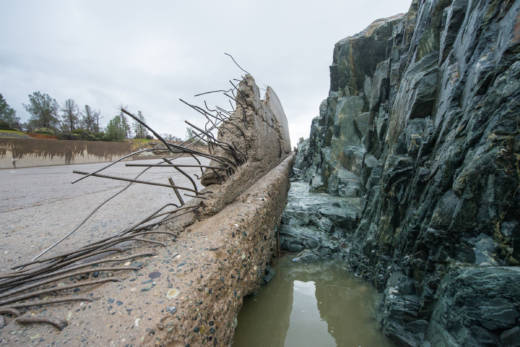The memo was released by the Association of State Dam Safety Officials and the United States Society on Dams, which assembled the team in March at the direction of the Federal Energy Regulatory Commission.
The report largely corroborates analyses from a team led by Robert Bea, an emeritus professor of civil engineering and leading expert in catastrophic risk management. Bea and associates concluded that the spillway was doomed by flawed design, construction and maintenance and that state and federal overseers were negligent in their response to spillway deficiencies.
The failure began, the independent forensic team says, as the Department of Water Resources increased flows down the spillway -- a step taken to make room in Lake Oroville for a surge of runoff from major winter storms in early February.
Although the flow coming down the concrete chute on Feb. 7 was far below both the design capacity and some past releases, the rapidly moving water started to pull the spillway apart. The forensic team says it believes water flowing through open joints and myriad cracks and other flaws in the concrete surface created excessive pressure beneath the chute that lifted up part of one 40-by-50-foot slab.
With the first slab dislodged, water plunged into the gap and rapidly eroded the spillway foundation, ripping out more slabs. By the time flows were stopped -- less than three hours after the initial breach occurred -- a crater had formed that was about 200 feet long and stretched nearly all the way across the 180-foot-wide spillway.
The forensic team said it was uncertain why the spillway failed in February after surviving earlier major releases. It said possibilities include recent damage or the deterioration of extensive earlier repairs; the expansion of voids under the slab that had formed due to long-term erosion; corrosion of reinforcing steel in the chute's concrete; and compromised steel anchor bars designed to help hold the concrete slabs in place.
The memo also catalogs a series of design and construction flaws that made the spillway vulnerable to failure. Among them, the report calls out a poorly designed drainage system installed in a way that some parts of the concrete slab were as little as 4 inches thick; insufficient steel reinforcement; failure to remove weathered rock and dirt from large sections of the spillway foundation; and an inadequate system for anchoring the slab to underlying rock.
The forensic team says it's still looking at what it calls the "human and organizational factors" that may have contributed to the spillway failure -- an inquiry that covers everything from how the Department of Water Resources made its initial decision on where to build the spillway to how it has inspected the structure.
The strongest language in the memo is in a final "lessons to be learned" section, where the forensic experts call on dam owners to perform periodic reviews of the original design and construction of their facilities and compare them to "current state of the practice."
"The (independent forensic team) has not seen any indication that such a review for the service spillway chute at Oroville Dam has ever been conducted since original construction," the memo said, "Such a review would likely have 'connected the dots'" and helped past safety reviews identify the factors that led to the spillway failure, the document says.
In a statement released after the memo was released, DWR spokeswoman Erin Mellon said the department "agrees ... that dam owners need to reassess current procedures."
Pointing to DWR's directive earlier this year for immediate reviews of the safety of nearly 100 dams statewide, Mellon said the department is determined to apply lessons learned from the Oroville crisis.
"The additional spillway evaluations already underway are the start of that process," she said.
This story includes reporting from The Associated Press.
